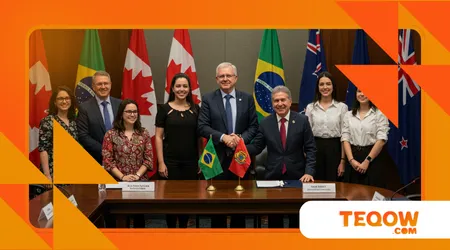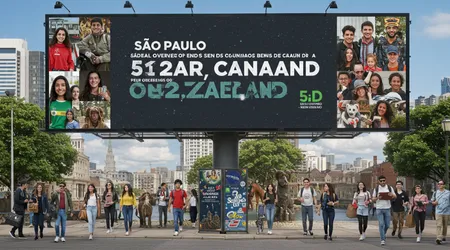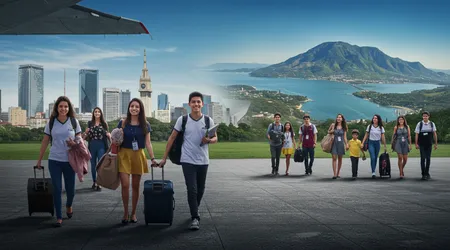São Paulo Government Sends 112 Students to Canada and New Zealand

São Paulo Government Sends 112 Students to Canada and New Zealand in a bold move to reshape public education.
Launched in April 2025, the “Prontos Pro Mundo” program has ignited excitement, sending 112 high-achieving public school students on a six-month journey to Canada and New Zealand.
This initiative isn’t just about travel it’s a calculated investment in Brazil’s future, fostering global perspectives and skills among young minds.
Why should a state prioritize such an ambitious program?
The answer lies in its potential to transform lives and communities.
By exposing students to diverse cultures, advanced education systems, and real-world challenges, São Paulo is planting seeds for innovation and leadership.
This article dives into the program’s mechanics, its impact on students, and its broader implications for Brazilian education.
From selection criteria to economic benefits, we’ll unpack how this initiative positions São Paulo as a pioneer in global education.
Along the way, we’ll explore real stories, hard data, and the ripple effects of giving students wings to soar.
Expect a deep dive into a program that’s as inspiring as it is strategic, with insights grounded in facts and a vision for a brighter future.
The “Prontos Pro Mundo” Program: A Gateway to Global Learning
The São Paulo Government Sends 112 Students to Canada and New Zealand through “Prontos Pro Mundo,” a merit-based initiative.
Targeting public school students aged 15-18, it rewards academic excellence and extracurricular engagement.
Students undergo rigorous selection, including exams and interviews, ensuring only the most dedicated embark.
In 2025, 56 students landed in Canada, and 56 in New Zealand, each for six months of immersive study.
This isn’t a vacation it’s a structured academic exchange. Students attend local high schools, live with host families, and engage in cultural activities.
The program covers flights, accommodation, and stipends, removing financial barriers.
According to a 2024 São Paulo Education Department report, 85% of past participants improved their English proficiency significantly.
++ EXPOCanada 2025 Attracts Brazilians Seeking Study and Immigration
This statistic underscores the program’s focus on tangible outcomes, not just experiences.
Beyond academics, the initiative builds resilience. Imagine a teenager from São Paulo’s periphery navigating Auckland’s public transit or debating in a Canadian classroom.
These moments forge adaptability and confidence.
The program’s design ensures students return not just with knowledge but with a global mindset, ready to inspire their peers.

Transformative Impacts on Students and Communities
When the São Paulo Government Sends 112 Students to Canada and New Zealand, it’s not just the students who benefit entire communities feel the ripple.
Take Ana, a 17-year-old from Diadema, who returned from Canada in 2024.
She launched a community English club, teaching peers what she learned. Her story shows how one student’s growth can uplift others.
The program fosters skills like critical thinking and cultural fluency. Students tackle real-world issues like sustainability in New Zealand’s schools bringing fresh ideas home.
Also read: Unitins Offers Exchange Program in Canada with April Deadline
They also gain confidence, with many reporting improved leadership abilities. This isn’t just anecdotal; the 2024 report noted 78% of participants pursued higher education post-program.
Communities gain ambassadors who challenge stereotypes. Students return with stories that spark curiosity, encouraging peers to dream bigger.
By investing in these young leaders, São Paulo creates a virtuous cycle of inspiration, education, and local development.
The impact is subtle but profound, like a pebble creating waves in a pond.
Moreover, the program bridges cultural gaps. Students act as informal diplomats, sharing Brazilian culture abroad. A São Paulo student teaching capoeira in Toronto?
That’s soft power in action. These exchanges build mutual respect, strengthening ties between nations and local communities alike.
Economic and Social Returns for São Paulo
The São Paulo Government Sends 112 Students to Canada and New Zealand, but what’s the return on investment?
Economically, educated global citizens drive innovation. Students return with skills that attract multinational companies to São Paulo.
A 2023 study by FGV showed that globally trained professionals boost local economies by 12% through higher productivity.
Socially, the program reduces inequality. Public school students, often from underserved areas, gain opportunities typically reserved for elites.
Read more: Study Permit Approvals Fall Sharply as New Rules Take Effect
This democratizes access to world-class education, leveling the playing field. The initiative also inspires policy changes, with other Brazilian states eyeing similar models.
Critics argue the program’s cost estimated at R$10 million annually could fund local schools. Yet, the long-term benefits outweigh short-term expenses.
Educated youth are less likely to face unemployment, reducing social welfare costs. By betting on its students, São Paulo is securing a competitive edge in a globalized world.
The program also enhances São Paulo’s global reputation. Hosting nations see Brazil as a partner in education, fostering trade and diplomatic ties.
It’s a win-win: students gain skills, and São Paulo gains influence. This strategic vision sets the state apart as a leader in education reform.
Challenges and Opportunities for Scaling
No program is without hurdles, even when the São Paulo Government Sends 112 Students to Canada and New Zealand.
Selection bias is a concern urban students often outshine rural ones due to better resources. The government is addressing this with outreach programs, but gaps remain.
Expanding access to preparatory courses could level the playing field.
Logistics pose another challenge. Coordinating 112 students across two continents demands precision. Delays in visas or host family placements can disrupt schedules.
Yet, these issues are surmountable with better planning and international partnerships. São Paulo’s government is already streamlining processes for 2026.
Scaling the program offers immense potential. Imagine doubling the cohort to 224 students or adding destinations like Australia. This would amplify impact but require more funding.
Public-private partnerships could bridge the gap, with companies sponsoring students in exchange for branding.
The opportunity to inspire other nations is equally compelling. São Paulo’s model could guide developing countries, proving education can be a global endeavor.
By refining and expanding “Prontos Pro Mundo,” São Paulo could set a global standard for educational exchange.
A Model for Global Education Collaboration

The São Paulo Government Sends 112 Students to Canada and New Zealand, but its vision extends beyond borders.
This program is a blueprint for international collaboration. Canada and New Zealand benefit too host schools gain diverse perspectives, enriching their classrooms.
A Toronto teacher noted Brazilian students’ “vibrant energy” transformed her class dynamic.
Reciprocity is key. São Paulo is exploring hosting Canadian and New Zealand students, fostering two-way exchanges.
This could deepen cultural ties and create a global network of young leaders. Such partnerships signal a shift toward education as a shared global responsibility.
The program also highlights technology’s role. Virtual pre-departure training and post-return mentorship ensure lasting impact.
Platforms like Zoom connect alumni, creating a community of change-makers. This blend of physical and digital exchange is the future of global education.
By leading with collaboration, São Paulo challenges traditional education models. It asks: why limit learning to one country when the world is a classroom?
This mindset could inspire a new era of borderless education, with São Paulo at the forefront.
Data Snapshot: Program Outcomes
The São Paulo Government Sends 112 Students to Canada and New Zealand, and the numbers speak volumes.
Below is a table summarizing key outcomes from the 2024 cohort, based on the São Paulo Education Department’s report:
| Metric | Result |
|---|---|
| English Proficiency Improvement | 85% of participants |
| Higher Education Pursuit | 78% enrolled post-program |
| Community Projects Launched | 42 initiatives by returnees |
| Program Satisfaction Rate | 92% of students and families |
This data highlights the program’s success in delivering measurable benefits, from language skills to community impact. It’s a testament to strategic design and execution.
Looking Ahead: A Legacy in the Making
As the São Paulo Government Sends 112 Students to Canada and New Zealand, it’s crafting a legacy. This isn’t just about 2025 it’s about the next decade.
Alumni are already mentoring new cohorts, creating a self-sustaining cycle of growth.
The program’s ripple effects will shape São Paulo’s future, producing leaders who think globally.
Sustainability is crucial. The government must secure long-term funding, perhaps through alumni contributions or international grants.
Engaging the diaspora Brazilians in Canada and New Zealand could amplify support. Their involvement could fund scholarships or mentorship, strengthening ties.
The program also sparks a broader conversation. If São Paulo can send students abroad, why not rethink local curricula to include global perspectives?
Integrating international case studies or virtual exchanges could scale the program’s ethos without added costs. The future is bright, but it demands bold, creative thinking.
Ultimately, “Prontos Pro Mundo” is a beacon of hope. It proves education can transcend borders, empower youth, and transform societies.
São Paulo’s investment in its students is an investment in a world where knowledge knows no limits.
Will other regions follow suit, or will São Paulo remain the trailblazer?
Frequently Asked Questions
Q: Who qualifies for the “Prontos Pro Mundo” program?
A: Public school students aged 15-18 with strong academic records and extracurricular involvement. Selection involves exams and interviews.
Q: How are host families chosen?
A: Families in Canada and New Zealand are vetted by partner organizations, ensuring safe, supportive environments aligned with students’ needs.
Q: What support do students receive abroad?
A: Students get stipends, academic guidance, and cultural orientation. Emergency support and regular check-ins ensure their well-being.
Q: Can the program expand to other countries?
A: Yes, discussions are underway to include destinations like Australia, pending funding and logistical agreements.
